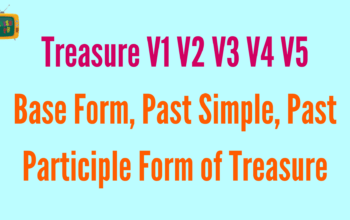Ache V1 V2 V3 V4 V5 is one of the verbs that are used very commonly in English tests as well as in everyday communication. Also, because it’s an irregular verb, ache doesn’t follow the regular rule. The verb “ache” has five different forms: base form, past simple, past participle form, present perfect, and present perfect participle. So what is ache‘s past? How do conjugate verbs with ache verbs?
⏩ Sign Up to Get Bonus
Let’s find out with English tivi in the article below.
See more at: Verbs
Ache of Definition and Meaning
Ache is a Greek word meaning pain or suffering, and it is often translated as “grief.”
V1 V2 V3 V4 V5 Form of Ache
| Base Form (V1) | ache |
| Past Form (V2) | ached |
| Past Participle Form (V3) | ached |
| s / es/ es (V4) | aches |
| ‘ing’ form (V5) | aching |
Ache of Past Simple V2
The verb Ache is also employed in its V2 form as “ached”’. It is used to indicate the past tense in sentences.
Ache of Past Participle V3
The V3 form is identical to the V2 form. The V3 form is “ached”. Ached is used in the past or present perfect tense.
+ In the present perfect tense, we use the word V1 as ‘have + ached‘ or ‘has + ached'.
- I, you, and we are used as ‘have + ached‘.
- ‘has + ached' is used for he, she, and it.
+ If you need to use the past perfect tense, use ‘had + ached‘ regardless of the subject.
You might also like: ALL the English Grammar Basics You Need
Conjugation of Ache V1 V2 V3 V4 V5
Conjugation table: Ache | |||
| Number | Singular | ||
| Present Simple of ache | I | You | She/He/It |
| ache | ache | aches | |
| Plural | |||
| We | You | They | |
| ache | ache | ache | |
| Present Continuous of ache | I | You | She/He/It |
| am aching | are aching | is aching | |
| Plural | |||
| We | You | They | |
| are aching | are aching | are aching | |
| Present Perfect of ache | I | You | She/He/It |
| have ached | have ached | has ached | |
| Plural | |||
| We | You | They | |
| have ached | have ached | have ached | |
| Present Perfect Continuous of ache | I | You | She/He/It |
| have been aching | have been aching | has been aching | |
| Plural | |||
| We | You | They | |
| have been aching | have been aching | have been aching | |
| Past Simple of ache | I | You | She/He/It |
| ached | ached | ached | |
| Plural | |||
| We | You | They | |
| ached | ached | ached | |
| Past Continuous of ache | I | You | She/He/It |
| was aching | were aching | was aching | |
| Plural | |||
| We | You | They | |
| were aching | were aching | were aching | |
| Past Perfect of ache | I | You | She/He/It |
| had ached | had ached | had ached | |
| Plural | |||
| We | You | They | |
| had ached | had ached | had ached | |
| Past Perfect Continuous of ache | I | You | She/He/It |
| had been aching | had been aching | had been aching | |
| Plural | |||
| We | You | They | |
| had been aching | had been aching | had been aching | |
| Future Simple of ache | I | You | She/He/It |
| will/shall ache | will/shall ache | will/shall ache | |
| Plural | |||
| We | You | They | |
| will/shall ache | will/shall ache | will/shall ache | |
| Future Continuous of ache | I | You | She/He/It |
| will/shall be aching | will/shall be aching | will/shall be aching | |
| Plural | |||
| We | You | They | |
| will/shall be aching | will/shall be aching | will/shall be aching | |
| Future Perfect of ache | I | You | She/He/It |
| will/shall have ached | will/shall have ached | will/shall have ached | |
| Plural | |||
| We | You | They | |
| will/shall have ached | will/shall have ached | will/shall have ached | |
| Future Perfect Continuous of ache | I | You | She/He/It |
| will/shall have been aching | will/shall have been aching | will/shall have been aching | |
| Plural | |||
| We | You | They | |
| will/shall have been aching | will/shall have been aching | will/shall have been aching | |
| Conditional Present of ache | I | You | She/He/It |
| would ache | would ache | would ache | |
| Plural | |||
| We | You | They | |
| would ache | would ache | would ache | |
| Conditional Perfect of ache | I | You | She/He/It |
| would have ached | would have ached | would have ached | |
| Plural | |||
| We | You | They | |
| would have ached | would have ached | would have ached | |
| Conditional Present Continuous of ache | I | You | She/He/It |
| would be aching | would be aching | would be aching | |
| Plural | |||
| We | You | They | |
| would be aching | would be aching | would be aching | |
| Conditional Perfect Continuous of ache | I | You | She/He/It |
| would have been aching | would have been aching | would have been aching | |
| Plural | |||
| We | You | They | |
| would have been aching | would have been aching | would have been aching | |
| Present Subjunctive of ache | I | You | She/He/It |
| ache | ache | ache | |
| Plural | |||
| We | You | They | |
| ache | ache | ache | |
| Past Subjunctive of ache | I | You | She/He/It |
| ached | ached | ached | |
| Plural | |||
| We | You | They | |
| ached | ached | ached | |
| Past Perfect Subjunctive of ache | I | You | She/He/It |
| had ached | had ached | had ached | |
| Plural | |||
| We | You | They | |
| had ached | had ached | had ached | |
| Imperative of ache | I | You | She/He/It |
| ache | |||
| Plural | |||
| We | You | They | |
| Let’s ache | ache | ||
See more at: Vocabulary
Example Sentences with Ache V1 V2 V3 V4 V5
In this section, we will learn about ache sentence examples:
- Her heart ached for those who had lost loved ones in the airline tragedy.
- My entire body aches.
- My stomach is aching from eating a lot of things.
- I ache in front of the homeless.
Synonym Words For Ache
Synonym of ache word list. Here are a variety of words whose meaning is nearly the synonym of ache:
- hurt
- smart
- sting
- throb
- tingle
- burn
- twinge
- cramp
- pain
- pound
- grieve
- sorrow
- agonise
- be painful
- be sore
- be tender
Opposite Words For Ache
The antonym of ache word list. Here are some words that have nearly the opposite meaning as ache:
- aid
- assist
- assuage
- help
- please
- relieve
- soothe
- alleviate
- allay
- mitigate
- rejoice
- delight
- be happy
- be glad
You might also like: Best List of Irregular Verbs in English
Some Frequently Asked Questions About Ache (Verb)
What is the V1 V2 V3 V4 V5 of ache?
The past tense of ache is ached. The third-person singular simple present indicative form of ache is aches. The present participle of ache is aching. The past participle of ache is ached.
| Base Form (V1) | ache |
| Past Form (V2) | ached |
| Past Participle Form (V3) | ached |
| s / es/ es (V4) | aches |
| ‘ing’ form (V5) | aching |
What is the V2 and V3 form of ache?
+ The V2 and V3 form of ache is “ached“.
What is the sentence of ache?
What is the past tense V2 of ache?
+ The past tense of ache is “ached“.
What is the past participle V3 of ache?
+ The past participle of ache is “ached“.
What is the present participle V5 of ache?
+ The present participle of ache is “aching“.
Conclusion
Let’s learn with English TV the structure of the verb “Ache V1 V2 V3 V4 V5“: Base Form, Past Simple, Present Continuous and Present Continuous and Present Continuous and Present Continuous forms. We wish you all the best of luck.
You should subscribe to the English TV YouTube channel if you want to learn more about the English language and improve your proficiency.





